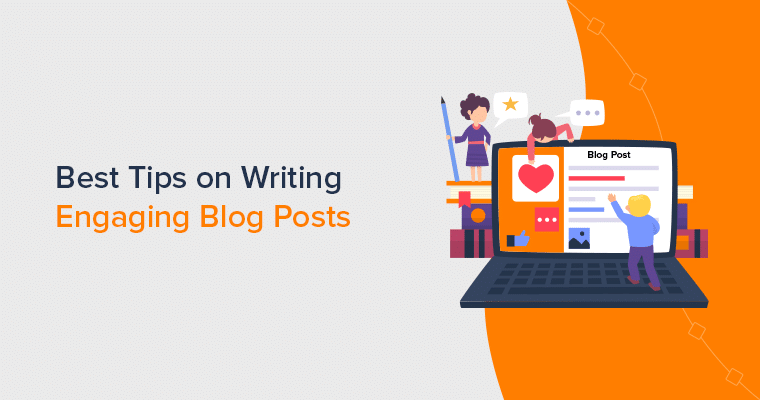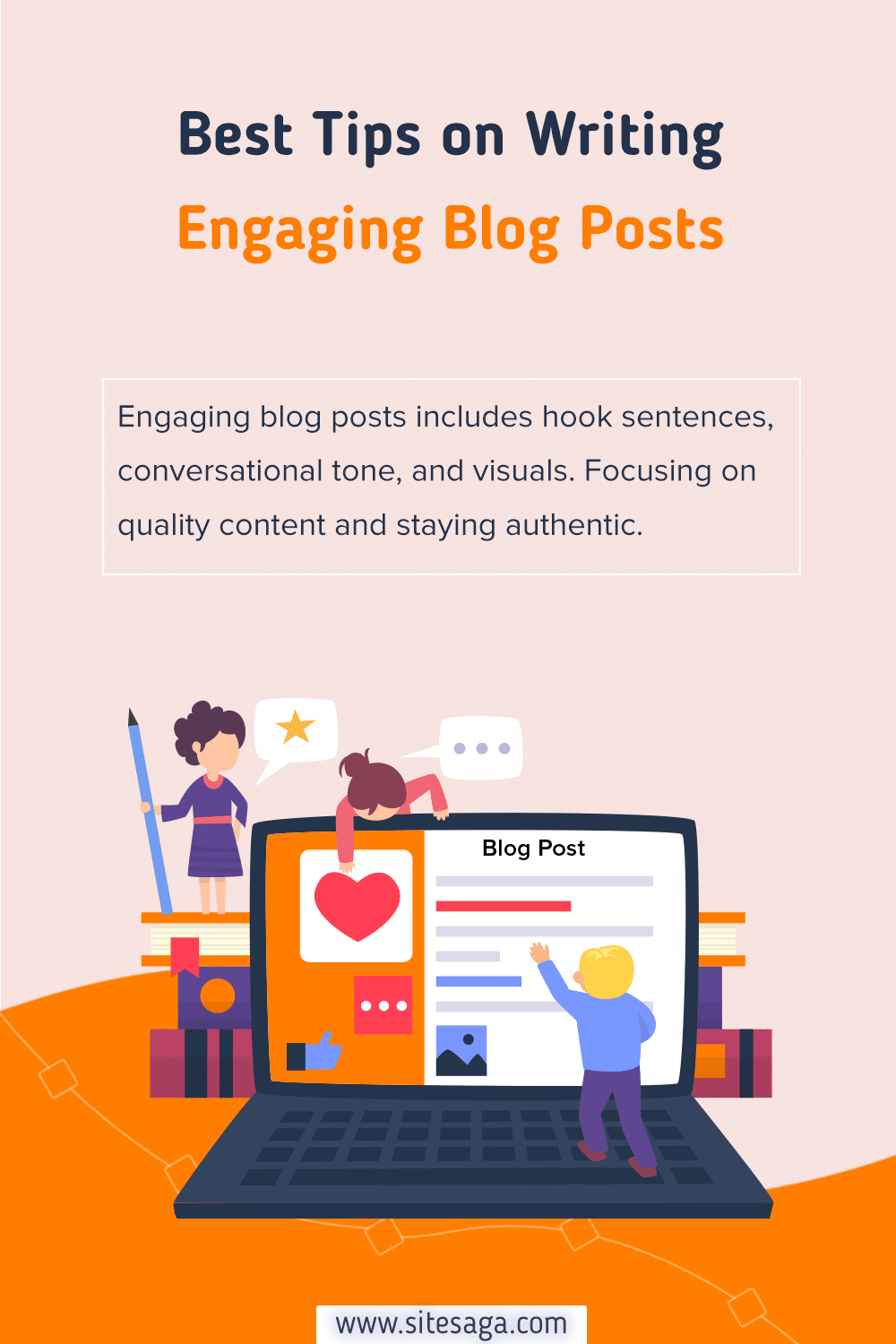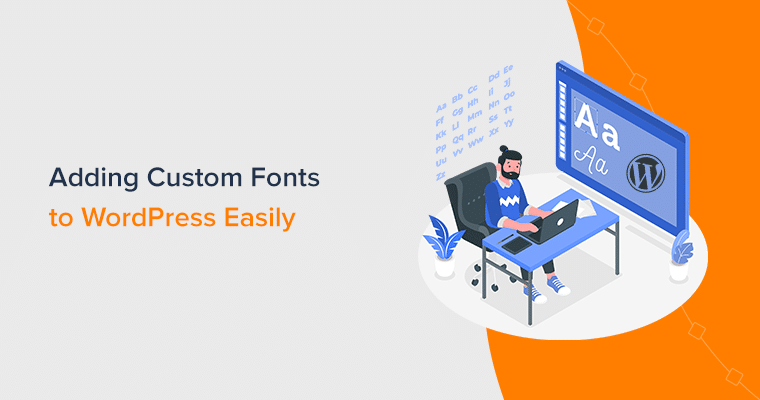Ever wondered how to write engaging blog posts that grab attention and make people want more? Do your blog posts need help to catch anyone’s eye? Well, you’re in the right place!
So, you’re writing, but it feels like no one’s listening. The problem? Your posts are getting lost in the crowd. We want to fix that. Short, snappy sentences can shake things up and make your writing stand out.
Writing engaging blog posts is more than just a skill. Use words that aren’t every day, give your writing a touch of uniqueness. This isn’t just about putting words on a page, it’s about creating an experience.
Make your content magnetic, something that pulls people in and makes them want more.
If you also want to learn how to write engaging blocks, then this article is just for you.
Without further ado, let’s get started!
Table of Contents
Importance of Engaging Blog Posts
A blog post is like having a friendly chat with someone online, but in written form. It’s a piece of writing on a website that shares information, thoughts, or stories about a particular topic. And there are about more than 600 million blogs out of 1.9 billion websites.
On top of that,
- On average 6+ million blog posts go live every day. (Source)
- And 80% of bloggers say that blogging drives results. (Source)
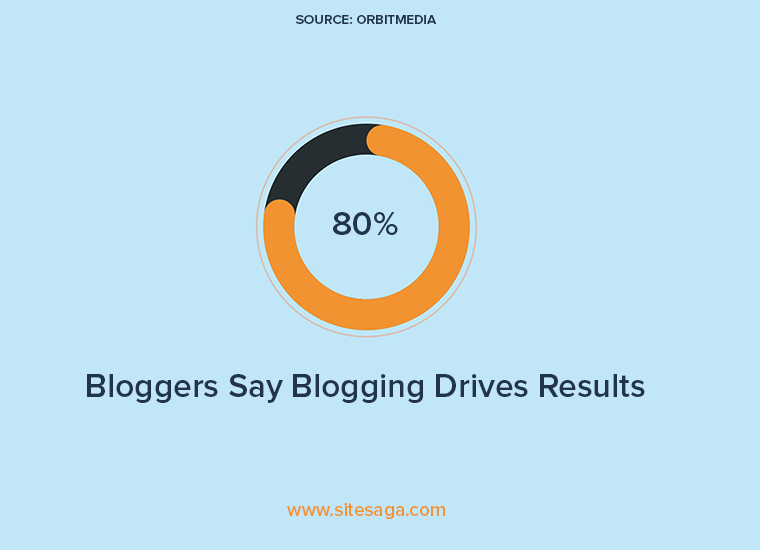
So, it’s not about the quantity of blog posts. It’s about the quality content that makes blog posts valuable for readers. It’s the way you present ideas, answer questions and value readers’ experiences.
And good content is always clear, and helpful, and leaves your readers feeling satisfied!
Let’s explore why it matters!
- Builds a relationship by addressing readers’ interests and concerns.
- Share valuable insights, keeping readers informed and engaged.
- Demonstrates expertise in a specific niche, gaining trust and credibility.
- Encourages interaction and discussion, creating a sense of belonging among readers.
- Provides a platform for creative expression, making content more enjoyable and memorable.
- Sparks conversations and sharing on social platforms, expanding the blog’s reach.
How to Write Engaging Blog Posts?
Now that you know about blog posts, let’s see how to write engaging blog posts for your website.
1. Identify Your Target Audience
To create engaging blog posts, the first step is to identify your target audience. Knowing who you’re writing for helps you tailor your content to their interests and needs. There are various ways to identify target audiences, some of them are:
I) Surveys
One strategy for identifying your audience is to conduct research. This can include surveys, interviews, or analyzing data from your website or social media platforms. Ask questions about their preferences, challenges, and what topics they find interesting.
II) Tools
Another popular technique is to use analytic tools to identify your audience, there are free and premium tools available for your disposal. Some of the popular tools are Google Analytics, Semrush, Google Trends, email campaigns, and various social media analytics.
These tools provide data on demographics, user behavior, and popular content. Analyzing this data helps you understand who is currently engaging with your content and what they enjoy.
III)Social Media
Social media platforms are powerful tools for audience identification. Join relevant groups and forums where your potential audience might participate. Pay attention to the discussions, questions, and content that resonate with them.

This social listening allows you to tap into the conversations of your target audience, gaining a deeper understanding of their interests. Encourage comments on your blog posts and social media channels, and take the time to respond to them.
As per the record,
- 98% of bloggers post content on social media and drive traffic. (Source)
- While 67% is from email marketing. (Source)
- And 13% of traffic is from paid services. (Source)
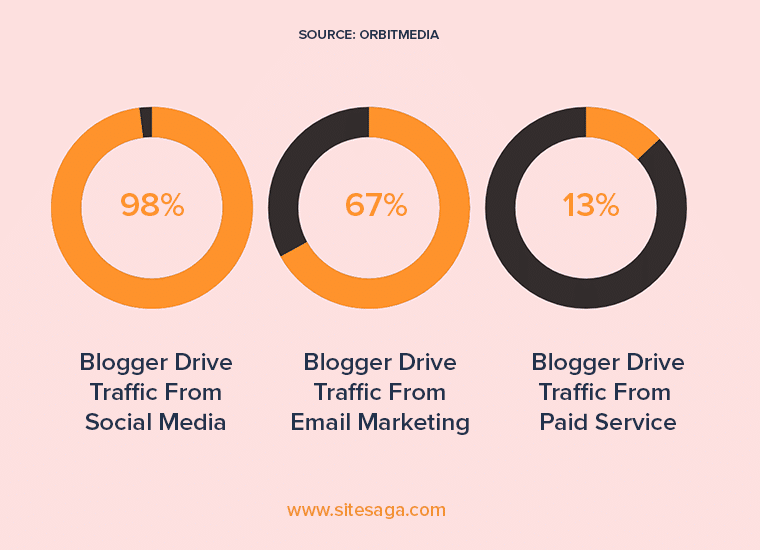
As you can see almost all bloggers post content on social media. It’s fast, easy, and free to use. So, why not give it a go?
2. Attention-Grabbing Headlines
Crafting attention-grabbing headlines is crucial for drawing readers into your blog posts. A compelling headline serves as a sneak peek, attracting your audience to explore further.
Here are some tips to create headlines that capture attention:
- Utilize keywords relevant to your content for better Search Engine Optimization (SEO) and visibility.
- Experiment with different headline formats, like how-tos, questions, or statements, to see what resonates with your audience.
- Keep headlines within an optimal length (usually 50-60 characters) for readability and to avoid page title clipping in search results.
- A/B test different headlines to determine which ones generate higher click-through rates.
- Create a sense of urgency with phrases like “Limited Time Offer” to motivate immediate action. And avoid using clickbait tactics that may lead to disappointment for readers.
- Continuously analyze and adapt your headline strategy based on the performance data and feedback from your audience.
Besides, you can use a headline analyzer tool to see if your headline is SEO-optimized and easy to read. Some of them are CoSchedule Headline Analyzer, Sharethrough Headline Analyzer, RankMath Meta Analyzer, etc.
3. Creating a Strong Opening
The beginning of your blog post sets the tone for the entire reading experience. Also, crafting a strong opening is essential to capture your audience’s attention. Getting readers hooked from the beginning is like saying “hello” to a friend, it sets a friendly tone.
Moreover, a strong opening makes people excited to read more. So, start with something interesting, like a surprising fact or a story that they can relate to. Imagine starting a conversation with a friend about something cool you discovered.
Some of the techniques are
| Element | Description |
|---|---|
| Fun Fact | Share a cool or interesting fact related to your topic to grab attention. |
| Curious Question | Ask a question that makes readers go, “Huh, I want to know the answer to that!” |
| Personal Connection | Tell a short, relatable story that ties into your blog post’s theme. |
| Bold Statement | Start with a strong and clear statement that sets the tone for what’s coming. |
| Relevant Quote | Use a quote that fits your topic and adds a touch of wisdom or insight. |
4. Enhancing Readability
Reading a blog post should be a breeze, not a puzzle. Enhancing readability is like giving your readers a comfortable chair and good lighting, it makes the whole experience enjoyable.
From font choices to paragraph structure, there are simple techniques to make your content easy on the eyes.
Let’s explore some strategies!
I) Clear and Readable Fonts
Choosing the right font is like picking the right outfit, it should look good and feel comfortable. Opt for clean, sans-serif fonts like Arial or Calibri, as they are easier to read on screens.
Also, keep the font size around 12-14 points for the main text. Ensuring it’s neither too small nor too large. Learn how to find the font used in your favorite website!
II) Short Paragraphs and Bullets
Long paragraphs can be overwhelming, like a dense forest of text. Break down your content into shorter paragraphs, each focusing on a single idea. Because short paragraphs with shorter sentences are easy to digest and make the reading experience smooth.
Furthermore, bullet points provide a visual break and make information digestible. Plus, readers love to skim, and concise, bulleted information facilitates that.
III) Subheadings for Organization
Subheadings are signposts, guiding your readers through your blog post. Clearly label different sections with descriptive subheadings. Not only do they break up the text, but they also help readers quickly find the information they’re looking for.
IV) Consistent Formatting
Consistency is the key to a polished look at your blog posts. Maintain a uniform font style, size, and color throughout your blog post. Many popular blogs have a Standard Operating Procedure (SOP), which helps a large number of editors and writers work without confusion.

Also, ensure that headings, subheadings, and body text follow the same formatting rules. This visual harmony makes your content more professional and reader-friendly.
V) Linking Strategically
Links guide your readers to more information on your website. When you include links, do it strategically, so it is easy for readers and web crawlers to index your site. Also, use descriptive anchor text, and ensure that the linked content is relevant.
Additionally, clustering is a popular internal linking strategy used in the blogging industry. This technique is also called the hub and spoke, or pillar model. Here, you create pillar/hub content and link-supporting spoke content.

Consider a blog post on the “Best WordPress Themes” as the pillar content. Each spoke, then, discussed subtopics like “Top Free WordPress Themes,” “Best Premium WordPress Themes for E-Commerce,” or “Best WordPress Themes for Bloggers.”
5. Using Engaging Visuals
Engaging visuals brings your content to life. Readers love to be visually stimulated, and infographics and other graphical elements can transform a bland blog post into an immersive experience.
Moreover,
- 26% of bloggers add videos to their blog posts. (Source)
- Whereas, 49% of bloggers add 2-3 images in one blog post. (Source)
- While 20% of them use 4-6 images. (Source)
- And only 2% use 10+ images in a single post. (Source)
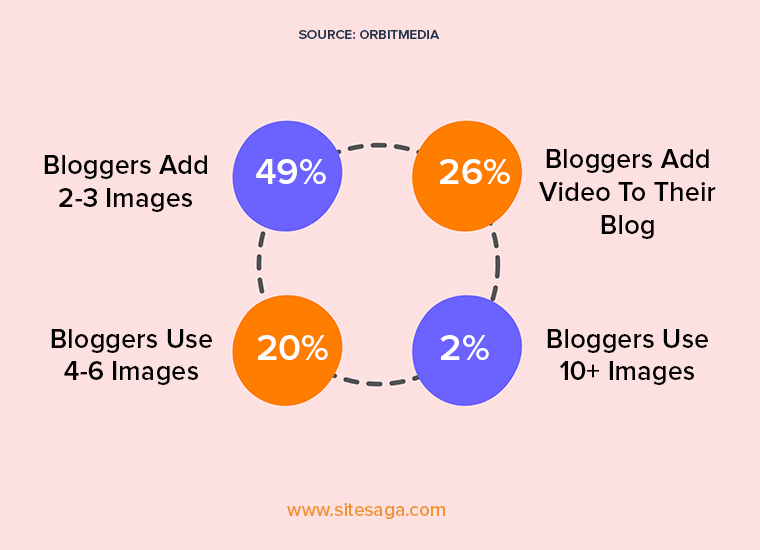
It may seem too much, but the internet is a visual place and as a blogger, you need to embrace this. Besides, on this blog, you’ll find more than 10 images, mostly infographics, screenshots, and charts.
How do you enhance the overall impact of your content using engaging visuals? Let’s see!
- Choose high-quality, relevant images that complement your content and grab the reader’s attention.
- Create visually appealing infographics to convey complex information in a digestible and shareable format.
- Maintain a consistent color scheme and use branded graphics to reinforce your blog’s identity and make your content recognizable.
- Use charts and graphs to illustrate data, trends, or comparisons, making your content more informative.
- Provide clarity by including screenshots or step-by-step visual guides, particularly useful in tutorials or how-to articles.
- Enhance your content with embedded videos to provide in-depth explanations, interviews, or demonstrations directly within your blog post.
Besides, all these, you can add a touch of humor or convey emotions with GIFs and memes. And create a more relatable reading experience.
6. Search Engine Optimization
Understanding Search Engine Optimization (SEO) is like learning the language that search engines speak. It’s about making your blog easily found when people search online.
SEO may sound complex, but it’s simply about helping search engines find your content easily. It’s like guiding them to your blog using the right words and signals.
Let’s look at its key aspects:
| Key Elements | How to do it? |
|---|---|
| Adding keywords | Keywords are the words people type into search engines. So adding appropriate keywords helps search engines connect your content with what people are looking for. |
| Catchy titles for search engines | Include your main keyword in the title. This tells readers what to expect and helps your blog show up in relevant searches. |
| Quality content | Aim for a balance between making your content readable for people and friendly for search engines. |
| Links for visibility | Internal links within your blog and links from other trusted sites tell search engines that your content is worth noticing. |
| Image optimization for search engines | Use descriptive filenames and add alt text to tell search engines what the images are about. |
| Speed matters | A fast-loading blog is better for everyone. Compress images and use tools to make sure your blog loads quickly. |
| Mobile friendly | Many readers use phones for browsing. So, make sure your blog looks good and works well on different devices. |
| Stay updated with changes | Search engines change their rules regularly. Stay informed about these changes and adjust your SEO strategies accordingly. |
There is a statistic that,
- 66% of bloggers drive traffic with proper SEO optimization. And you should know that organic search is mostly a durable source to drive traffic. (Source)
- Also, there is a report that 26% of bloggers get good traffic based on keyword searches. (Source)
- Besides, 39% of bloggers always research keyphrases. (Source)
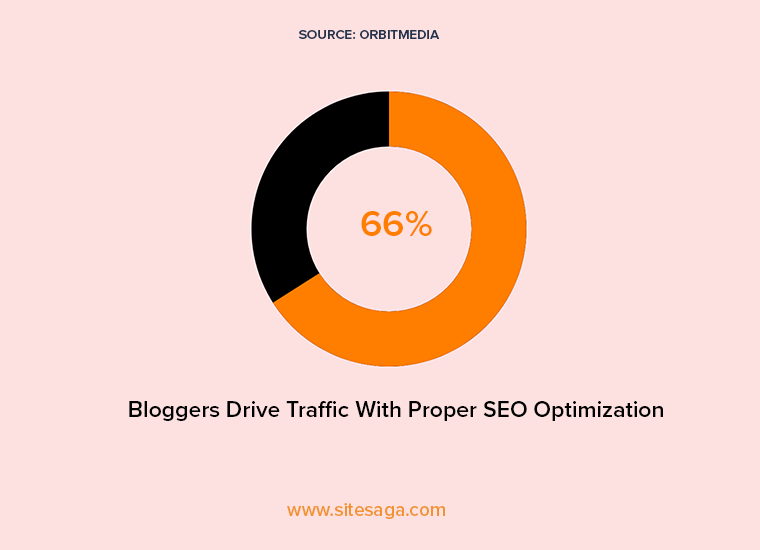
So be mindful that, achieving even a handful of significant SEO victories can attract substantial traffic and enhance brand visibility.
To make your website load faster, check these speed optimization plugins.
7. Writing in Conversational Tone
Making your blog post shine also includes how you write your posts. You must make your readers feel like having a conversation with you.
Writing in a conversational tone is like having a friendly chat with your readers. It helps to establish a connection with them.
Let’s explore how to make your writing feel like a warm conversation!
- Begin your blog post with a friendly greeting, as if you’re welcoming readers into a cozy space for a chat.
- Don’t be afraid to use words like ‘you’ and ‘we.’ It makes your readers feel included.
- Use short sentences and everyday language to make your blog feel like a natural conversation.
- A light and funny touch can make your blog more enjoyable and memorable for your readers.
- Add anecdotes and relatable scenarios to engage your readers on a personal level.
- Encourage readers to share their thoughts in the comments, turning your blog into a lively space for discussion.
- Be authentic and let your unique voice shine through, it builds trust and connection.
So, make use of friendly chat, greet your readers warmly, and let your words create meaningful conversations.
8. Adding Relevant Data and Statistics
Using real facts and numbers is like adding strong support beams to your content. It not only makes your blog more trustworthy but also makes it interesting for your readers.
You say how? Let’s explore!
I) Start with Solid Facts
Begin your blog post with strong facts. For instance, did you know that most people love content with numbers? This sets the stage for a blog post that’s packed with useful information.
II) Get Insights From Research
Look into reports and studies to give your readers the latest insights. For example, sharing data from trusted sources like Statista makes your blog a reliable place for valuable information.
III) Prove Your Point with Numbers
Back up what you say with actual numbers. For instance, 50% of bloggers use statistics in their posts. Abd 30% of bloggers say it works in getting positive results.
Therefore, using real data ensures your readers get information they can trust.
IV) Spotlight Trends with Data
Explore trends in your field supported by data. For example, mentioning 70% of consumers learn about a company through blog posts rather than ads. This gives your blog statistical evidence and shows you know what’s happening in your industry.
V) Compare to Understand
Compare things using data for a deeper understanding. For instance, comparing product features or growth rates gives your readers more context. It’s like giving them a closer look at what’s happening.
As per the numbers,
- 56% of websites say blog posts deliver strong marketing results. (Source)
- While 26% believe it can drive some results. (Source)
- Whereas, only 11% say it got them disappointing results. (Source)
- And a few 7% said they don’t know if the blog post has any value. (Source)
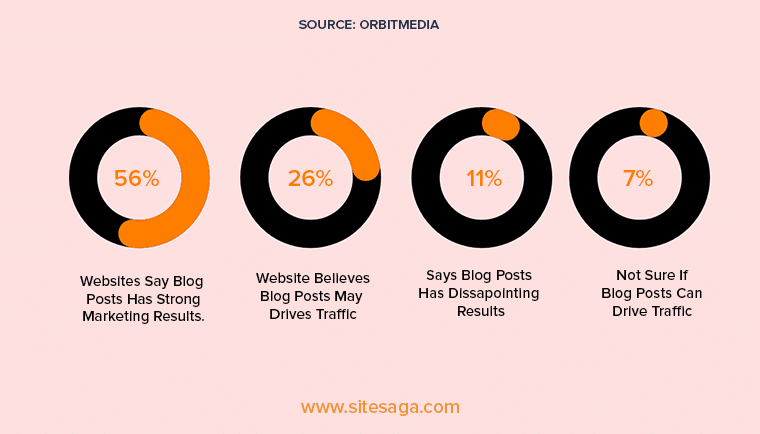
So looking at the numbers above, you can get a clear idea of what blog posts can do for your business. Likewise, you can add some facts and stats in your post to make it more valuable for your readers.
9. Avoid Unnecessary Fluff
In the world of blogging, less is often more. Avoiding unnecessary fluff in your content doesn’t bore or exhaust your viewers. Because readers appreciate clarity and value their time.
Let’s explore how trimming the excess and getting straight to the point can make your blog posts engaging and enjoyable.
I) Be Direct and Concise
Readers appreciate content that gets to the point without unnecessary turns. So, being direct and concise respects your audience’s time and enhances the clarity of your message. Therefore, trim away any redundant words or phrases that don’t contribute to the main idea.
II) Avoid Repetition
Repetition can be distracting to your readers from your core information and dilute your message. Many readers do not have time to deal with reparations and this can frustrate them hurting your site retention rate.
Therefore, once you’ve conveyed a point, resist the urge to repeat it. Trust that your readers grasp the information, and move on to provide new insights or details.
Iii) Edit and Re-edit
Editing transforms your good content into great content. Also, do not hesitate to cut out any sentences or paragraphs that don’t serve a clear purpose. Step back, review your work, and look if each element contributes significantly to the overall quality of your blog post.

Repeat this process till you or your team is satisfied with the piece. It’s the commitment to this editing that makes your blog post stand out from the competition.
10. Engage Readers with Questions
When it comes to making your blog more interesting, using questions is a great way. Also, using questions is like having a conversation with your readers. It’s a way to get them thinking and sharing their ideas.
Here’s how you can engage your readers by asking them thoughtful questions:
- Begin your blog post by asking a question related to your topic.
- Ask questions that make readers reflect on what you’re talking about.
- Understand your audience and tailor your questions to match their interests.
- Place questions strategically in your content. Whether it’s after an interesting point or between sections.
- Experiment with different types of questions. Open-ended questions, which don’t have a specific answer, encourage diverse responses.

What does it do?
- Questions prompt readers to actively think about the content. This shifts the reading experience from passive consumption to active engagement.
- When readers respond to questions in the comments section, it builds a connection between you and your audience.
- By asking questions that relate to their interests and experiences, you show that you value their input.
- Creates a dialogue not only between you and them but also among the readers themselves.
- Reader engagement, especially through comments, can boost your blog’s visibility.
So, you can say that engaging readers with questions is a dynamic strategy that transforms a blog into an interactive space. It adds layers of richness to the content and contributes to the overall success of the blog.
11. Asking Readers for Comments and Feedback
As a blogger, the significance of reader comments and feedback cannot be ignored. Encouraging readers for feedback is a simple yet effective way to turn your blog into a place where ideas flow freely.
It’s a way to make your content more dynamic and inclusive.
Here’s how you can encourage them to leave comments and provide feedback:
- Add phrases like “Join the Conversation,” to set the stage for an inclusive exchange.
- Include questions in your content that encourage readers to think and respond.
- Put prompts strategically in your content to guide readers toward engagement.
- Show appreciation for your readers’ time and input. Phrases like “Your Thoughts Matter” create a sense of belonging.
- Acknowledge readers’ input, answer questions, and encourage further discussion.
- Showcase comments from readers in future posts to acknowledge their contribution.
- If readers suggest something or provide feedback, consider implementing their ideas and give them credit.
You ask why readers’ feedback is important. Here’s why,
- Engagement and interactions: Transform your content from a one-way communication channel to an interactive platform.
- Diverse perspective: Each reader may have a unique viewpoint, personal experiences, or additional insights to offer, enriching the overall content.
- Identifying popular content: Monitoring which posts receive more comments and feedback helps you understand what resonates most with your audience.
- Correcting misunderstandings: Responding to comments allows you to clarify any misunderstandings, ensuring that your message is conveyed accurately.
- Loyal visitors: When readers feel heard and appreciated, they are more likely to return to your blog for future content.
So, invite your readers to share, interact, and let your blog be a space where diverse voices come together.
12. Adding Call-to-Action
Getting your readers to take action is like adding a special touch to your content. And a good Call-to-Action is like a friendly invitation. It’s not just telling your readers what to do, it’s asking them to be part of the action.
For instance, once you visit SiteSaga you’ll see an eye-catching CTA in the top-right corner of every blog post. Which says, “START YOUR WEBSITE NOW!” once you hit the button it takes you to the tutorial on how you can build your site from scratch.

So, add compelling CTAs to your content, guiding your readers to interact and make your blog a lively and interactive space.
Let’s explore how to use CTAs effectively and boost engagement in your blog.
- Know what you want: Whether it’s signing up for emails, joining discussions, or making a purchase, having a clear goal shapes how you ask.
- Use friendly notes: Instead of plain phrases, use words that connect with your readers, like “Get Exclusive Access” or “Join the Chat Now.”
- Put in the right place: Put your CTA where it naturally fits in your content. It should be a seamless part of the reading experience, not something that interrupts it.
- Make it eye-catching: Use colorful buttons or banners that stand out. Think about the colors like red for urgency, blue for trust, or green for action.
- Think about mobile users: Make sure your CTA looks good on small screens. Adjust its size and design so it’s easy to see and click on mobile devices.
Besides, finding the best CTA is like a little experiment. So, do try different versions, see how they work, and make changes if needed. As it’s a process that helps you figure out what your readers respond to best.
13. Regularly Updating Blog Posts
Keeping your blog interesting involves keeping your content fresh. And, regularly updating your blog posts is a key way to achieve this.
Think of your blog as a conversation. So, to keep it interesting, you need to talk regularly. Whereas, updating your blog posts consistently is like keeping the conversation flowing. It helps your audience know when to expect something new from you.
As for the example, you can see our blog SiteSaga also keeps the posts updated.
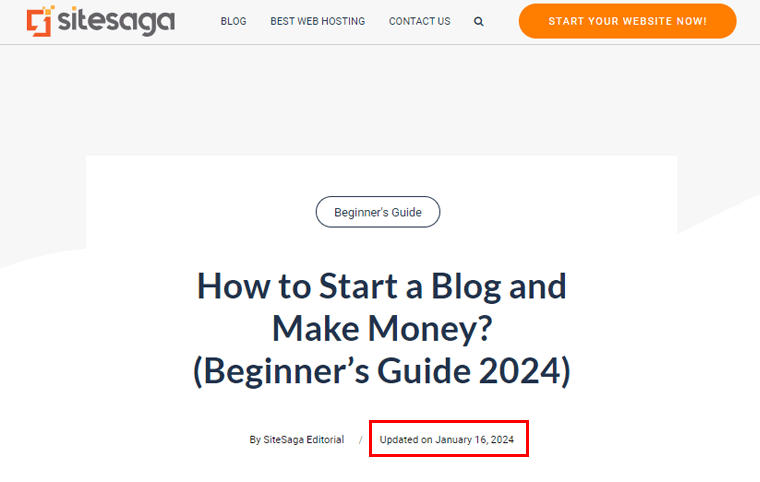
Moreover, 74% of bloggers update old articles, making it a part of content strategy. This shows greater number of bloggers do return to old posts and update them.
Well, it does pay off!
Also, think ahead about when to refresh your content. Whether it’s an annual review, an event update, or a seasonal change.
Planning is all you need!
14. Consistent Posting Schedule
Lastly, don’t forget to publish your blog post consistently. Because it’s the heartbeat of a successful blog. This establishes a rhythm that your audience can sync with, creating an anticipation that keeps them coming back for more.
What you need to keep in mind is,
- Find the right frequency for your blog posts.
- Consider your audience’s habits and time zones, so you can publish at the right time.
- Too frequent can risk overwhelming your audience.
Moreover, when you stick to a set schedule, it builds trust with the audience, who come to expect new content at certain times. Having a steady posting routine not only makes a blog more visible online but also helps it grow over time.
Because search engines like regularly updated content. So having a consistent schedule can improve a blog’s chance of being discovered.
Putting in more effort usually leads to better outcomes. If you publish a lot of content, then you’re more likely to see positive results.
What Do the Best Blog Posts Have in Common?
The best blog posts share common traits that elevate them above the rest. Here’s what they typically have in common:
- Compelling Headlines and Openings: Eye-catching titles grab attention and entice readers to click. While captivating introductions hook readers from the start.
- Relevant Content: Addresses the audience’s needs, interests, or problems.
- Visual Appeal: Incorporates images, infographics, or videos to enhance understanding.
- Authentic Voice: A unique tone or style that reflects the blogger’s personality and authenticity.
- Interactive Elements: Encourages reader engagement through comments, polls, or calls to action.
- Closing Impact: Strong conclusions that leave a lasting impression or prompt further action.
- Feedback Consideration: Takes into account reader feedback for continuous improvement.
Want to know what top bloggers do differently? Let’s take a look at the below data!
- So, 46% of bloggers publish 2000+ words of articles. (Source)
- While 44% of bloggers publish new content(s) weekly. (Source)
- And there are always more than 7 images on each blog post. (Source)
- 37% of them collaborate with influencers on most blog posts. (Source)
- Time is money, so 35% of bloggers spend 6+ hours on a single article. (Source)
- Plus 34% of bloggers say adding video to most articles is helpful. (Source)
With all these, you may want to create your blog, so take some references from the best blog websites.
So now you know how to write engaging blog posts, it’s time to answer some of your burning questions.
Frequently Asked Questions
1. What is a hook sentence for a blog?
A hook sentence in a blog grabs attention with a compelling opener, be it a thought-provoking question, intriguing fact, or personal anecdote.
2. What type of content is most engaging?
Engaging content varies, but visuals, storytelling, and interactive elements like polls captivate. Practical solutions and diverse formats cater to universal interests.
3. What is the best blog platform to start a blog?
WordPress suits customization, Blogger offers simplicity, and Squarespace adds a professional touch. The choice depends on personal needs and comfort with platform features.
4. What is the most popular blog format?
Popular formats include listicles for easy reading, how-to guides for practicality, and storytelling for relatability. However, effectiveness depends on content purpose and audience preferences.
Conclusion
Well, that’s all for now!
In this article, we’ve shown how to write engaging blog posts for your website.
We hope that this guide helps you to know the secrets of increasing blog post engagement. If we missed anything, then comment on them.
Moreover, if you’ve any queries or suggestions regarding how to write engaging blog posts, then let us know in the comment below. Besides, you can also share your experience of writing blog posts with us.
You can also check out our complete guide on the best WordPress blogging themes and the benefits of personal blogging.
If you like this article, then please share it with your friends and colleagues. Also, don’t forget to follow us on Twitter and Facebook.
